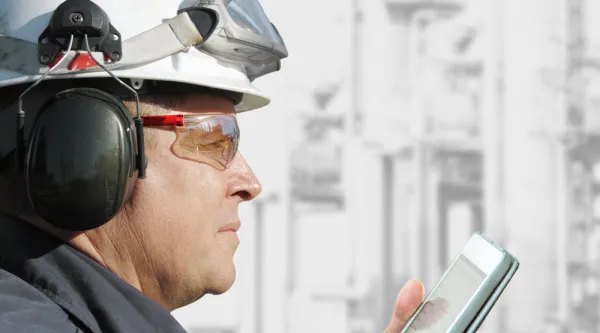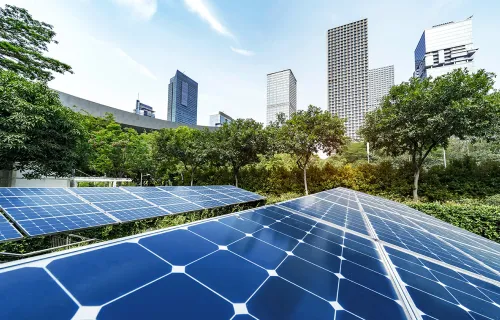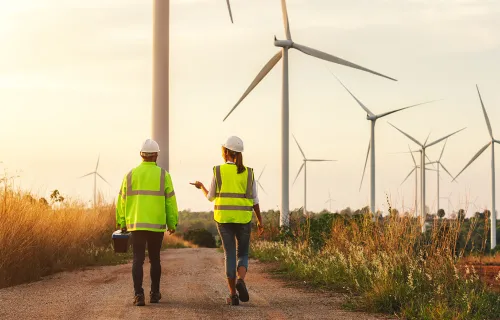00:00:08:11 - 00:00:35:03
Niamh Callaghan
Hello, I'm your host today, Niamh Callaghan, a consultant within CGI’s energy transformation sector. In this podcast today, we will take a look at the current challenges facing energy companies regarding the generation of renewable energy. There are many implications for renewable energy generation from high construction and infrastructure costs and power storage to optimizing maintenance and a lack of government policy and subsidy.
00:00:36:04 - 00:00:56:13
Niamh Callaghan
I'm here with two members from our energy transformation team who have been working within energy, oil, and gas for over 25 years. Today, we'll examine the challenges and opportunities and the valuable role of data in bridging the gap between conventional and renewable energy generation. So I'm pleased to say that I am joined by two of our experts, Shan Roy and Joe Dipple.
00:00:56:21 - 00:01:04:22
Niamh Callaghan
Hi Shan. Hi, Joe. With renewables, which particular energy types are the focus of what challenges do these cause?
00:01:05:02 - 00:01:40:02
Joe Dipple
Yes, I think it's evident that there is a significant amount of investment going into offshore wind. So, I read an article recently which forecasts the global installed offshore wind capacity is expected to reach 630 gigawatts by 2050, which is up from only 40 gigawatts just a couple of years ago. And I think this this growth in investment is obviously being driven by the availability of higher wind speeds and consistency in the direction of the wind at these offshore locations.
00:01:40:27 - 00:02:37:24
Joe Dipple
And you have the obvious advantage of space. So, the oceans they provide, okay, the perfect location to build wind farms in terms of scale and openness. And within that offshore growth, floating offshore is becoming a major topic. Floating wind turbines - they don't need to be grounded in the seabed like fixed bottom turbines so they can be sited much further out to sea in much deeper water where the winds are even stronger. So obviously have the potential to be able to generate much more energy due to those conditions further offshore. And I think floating offshore will be able to build on the developments made by the seabed-fixed offshore wind to reach scale even faster, much as kind of today's offshore wind industry in general was built on the achievements within onshore.
00:02:39:04 - 00:03:08:02
Joe Dipple
But as you referenced, this won't be without challenge; investment and government backing is going to be absolutely crucial to really ensure that that capacity grows in a sustainable way. We really can't forget that also, there really is a need to have the right technology available to both support the operation of the wind farm, but also leverage the data that will be available.
00:03:09:20 - 00:03:28:13
Joe Dipple
But wind is really only one part of the puzzle. Solar is another key source of generation. And Shan did you want to provide some insight into how solar is contributing to the mix and perhaps some of the challenges faced with that source of renewable energy?
00:03:28:16 - 00:04:09:12
Santanu Roy
Yes. Thanks, Joe. As you alluded to, yes, Solar is also a viable alternative. It's not new, though. The solar photovoltaic cells and solar farms have been an interest and an investment of many countries and commercial organizations, especially the energy organizations. But they have been building some of these across the globe. But as we know, sun doesn't shine everywhere and not at kind of every time of the day.
00:04:10:10 - 00:04:42:12
Santanu Roy
The farms have been productive, but they can only function when there is adequate amount of sunlight. But bringing that to kind of the plate today, though, the organizations across the globe and they are not just need to be from the energy sector, any commercial organizations, etc., they have also started tapping into solar energy by kind of installing solar panels on their facilities.
00:04:42:13 - 00:05:12:22
Santanu Roy
So, a good example would be like data centres like IT organizations who have large data centre facilities. They see the installation and then the generation of power through these solar panels to offset some of their carbon footprints. So it's becoming, from a B2B perspective, from a commercial perspective and renewable energy source generation, and obviously then consumptions for their own needs.
00:05:13:01 - 00:05:44:07
Santanu Roy
And it's not just only for the organizations from a B2B perspective, lots of homes and kind of buildings are also getting into using solar as a viable alternative, which creates our own challenge of managing the energy generated from solar and then consuming, but then also thinking about how storing whatever is excess, if there is any. Joe.
00:05:44:19 - 00:06:33:03
Joe Dipple
Thanks, Shan. And I think the final point to mention here is, and it's a very important trend right now, the role of hybrid assets and plants and the role they will play. So, this is about different combinations between production and storage. So, wind and solar, wind and storage, solar and storage. And I think hybrid plants can really present many benefits when compared to a pure wind farm or pure solar farm or other kind of pure renewable power plants that they really have the potential to provide an optimal combination of both solar, wind and storage to deliver stable round the clock power.
00:06:34:04 - 00:06:41:22
Niamh Callaghan
So, we've discussed onshore and offshore wind as well as solar, Shan, are any other types of energy that we should be highlighting here?
00:06:43:02 - 00:07:16:03
Santanu Roy
Yeah, indeed. I mean hydrogen comes to mind, it is obviously currently being in top of the charts of alternative and renewable energy sources that a lot of organizations and initiatives are concentrating to make hydrogen as potentially a replacement of the current fossil fuel. And now there are different ways you can produce hydrogen, and there are different types.
00:07:16:03 - 00:07:47:10
Santanu Roy
We talk about multiple colours. They are all colour coded. Green hydrogen is currently the one that gets generated by the source using natural gas or methane or coal. And then that's not one of the purest one. But then you have the blue hydrogen where whatever the steam comes out when that was part of the electrolysis process in the creation of hydrogen, the steam that has been formed that is been captured and stored.
00:07:47:11 - 00:08:20:17
Santanu Roy
So, the blue hydrogen is it's also called as a carbon neutral option. And rather than obviously dispersing the steam into the atmosphere, but then you have the green hydrogen, which is called also a clean hydrogen, because it is produced using electricity or generated or power generated from renewable sources. It can be from solar or wind energy generating the power, and then that power being used to do the electrolysis and production of the green hydrogen.
00:08:20:17 - 00:08:49:27
Santanu Roy
So green hydrogen is the one that everybody is concentrating on, on how they can maximize how the different renewable energy sources that Joe talked about, and I talked about can contribute to the production of this green hydrogen and then have a hydrogen value chain, which is from production to transportation and consumption of hydrogen into this mix.
00:08:50:06 - 00:09:52:24
Santanu Roy
But like other energy sources, it also has its own challenges. So the challenges, as I explained earlier, there are different ways you can generate hydrogen based on the colours. But there's the main area is the transportation and distribution, because there are some safety concerns and challenges there, but also how hydrogen is used for industrial or commercial purposes and also mainly for transport when it comes to shipping or aviation cars.
we’ve got rail, trucks as well, which needs a bigger storage area and much more safer alternatives for hydrogen, for trucks, etc. and obviously commercial road transport, the wider vehicles as well involved in that. So, it comes with the challenges of storage, distribution and then obviously consumption.
00:09:53:29 - 00:10:03:25
Niamh Callaghan
So now we understand the different types of energies that are out there. Joe, what do you think the role of data is in bridging that gap between the conventional and the renewable?
00:10:04:06 - 00:10:30:25
Joe Dipple
Yeah, so this is a really interesting topic. I attended Wind Europe 2022 in Bilbao. And one of the key takeaways for me was that IT and data were really not one of the main topics of conversation at the conference and it didn't feel like IT was yet embedded into what the industry is trying to achieve, which is somewhat at odds with other industries.
00:10:30:28 - 00:10:56:13
Joe Dipple
So, so for example, the finance industry is completely embedded. So, I suppose the key questions I came away with were; is the value of data truly recognized by the sector yet, or is it the case that there is currently a lack of confidence in the data being gathered and used? And I think another important consideration and linked to what I just said is that the data currently being gathered and in use is not standardized.
00:10:57:00 - 00:11:20:04
Joe Dipple
It really does impact the ability to scale solutions. And ultimately that's going to need to change and improve as we move forwards to a more open, data driven and agile component-based landscape. So just coming back to the question, I think the key part of data bridging the gap will be found in solutions and building intelligence on top of the data.
00:11:20:28 - 00:11:54:18
Joe Dipple
So, it's certainly an area that I think is still evolving and there is still a pretty long way to go, but there are some really interesting use cases. So, for example, some in relation to trading. So, there are there are algorithms that take data from forecasts from different energy production sources. So, wind, solar in combination with storage and also together with data around the consumption forecast to really enable better energy trading decisions in real time, obviously with the intention of maximizing revenue and profit.
00:11:54:29 - 00:12:10:20
Joe Dipple
And so in in summary, I think I think data is going to be crucial and it's going to be it's going to be so important to pull together the right data sources in real time to enable efficient and effective decision making.
00:12:11:11 - 00:12:22:06
Niamh Callaghan
So, it's clear that data is going to be incredibly important. But I think there's still a little bit of a way to go until we get to that point. So what does success look like for these organizations right now?
00:12:22:26 - 00:13:47:10
Santanu Roy
Maybe I could make a start; from a business perspective, this is a discussion about transitioning from the conventional fossil-fuels based value chain to a power based value chain. So, this is a journey everyone is on from a business perspective. All the businesses that we speak to, they will obviously grow and optimize their portfolio, i.e. they want to build or buy effectively new asset types, whether it's a wind farm or a power plant or a solar farm, as we were discussing earlier, and get the most out of that asset or group of assets by generating it up to the maximum capacity of power that it should be generating very low downtime because when those assets are not generating power, they're not actually doing anything. So, any kind of maintenance downtime or planned maintenance is kept to a minimum. So that's what sets us up. That's the more power can be generated, the more power can be distributed quickly, and the assets can be bought quickly, integrated to the operations quickly and generating the power, but also the distribution, etc.
00:13:47:17 - 00:14:23:11
Santanu Roy
But then also off-boarded quickly. Because if the businesses want to sell something because they want to buy something bigger, how easy operationally it becomes is going to be a key success factor going forward. Businesses also are looking for generating new value in the event the whole value chain and measuring better performance, like focusing into better energy management solutions, better production forecasting solutions.
00:14:24:19 - 00:15:05:13
Santanu Roy
I already mentioned about the operational side, so surely production optimization is top of their head in terms of how they can achieve better optimization by obviously doing predictive maintenance and supervision and control, but also managing all the associated elements like managing of the spare parts and workforce optimization of the people who are securely working in these renewable power generation side, but also distribution into the wider partner ecosystem is effectively working safely from a business perspective.
00:15:05:13 - 00:15:41:15
Santanu Roy
I think Joe did touch upon the data element. I think that's also key from a success perspective. The business leaders within the renewables industries are looking for how they can leverage digital and better insights are being derived from the data they have today, but also the data that gets generated as they grow their portfolio and which helps them to better analyse the generation versus the demand that is coming from the consumption side.
00:15:41:15 - 00:16:15:22
Santanu Roy
So the business wants to make better decisions, making it more dynamic for them to help them through the peaks and growth of the of the of the customer demands. And finally, they want to have a predictable cost of the transformation. As I said earlier, from a journey perspective, this is an energy transition journey. It is a business transformation for the organizations in this energy space.
00:16:15:22 - 00:16:35:17
Santanu Roy
And they want to obviously have a predictable transformation cost to give energy as a service to their end customers from their business perspectives. Maybe, Joe, you can highlight what success looks like from the technology side.
00:16:36:08 - 00:17:20:19
Joe Dipple
Yeah, thanks Shan. I guess to two points to add for me, firstly, I think automation is going to be key, particularly in the operation of the assets from a cost and efficiency perspective. Automated solutions are going to play an absolutely crucial role in creating a successful operation. And then I guess the final point for me is that I think it's going to be more important than ever that these organizations, both from a strategic business, but also technology perspective, are able to effectively manage, operate, optimize global asset portfolio across all energy types.
00:17:21:12 - 00:17:42:27
Joe Dipple
And I think the emerging strategy to achieve that is through one consistent system or platform that enables the data to be thoroughly leveraged to extract the maximum value. And this is really a topic that I'm sure Shan, me and you and the wider CGI team would love to have further discussions on.
00:17:44:00 - 00:18:11:10
Niamh Callaghan
So that's been a really interesting discussion. Thank you both so much for your time today. For more information on renewables or anything else that CGI do, you can visit our web-page or you can connect directly with Sian and Joe on LinkedIn. I hope you've enjoyed listening to our podcast today. Please make sure to check out the other experienced CGI podcasts on the channel.






